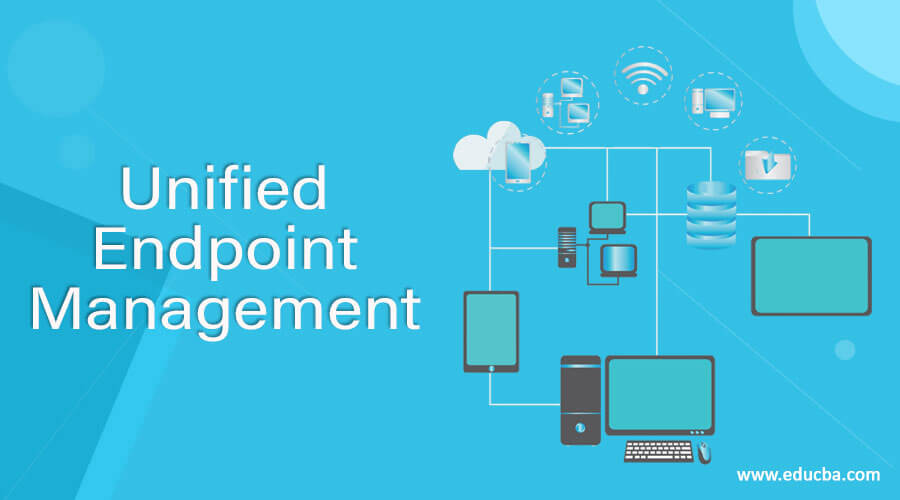Updated March 8, 2023

Introduction to Unified Endpoint Management Tool
Unified endpoint management (UEM) tool helps organizations to manage and control devices through a single interface. Nowadays, all companies use internet-based devices such as desktop computers, barcode scanners, mobiles, wearables, cameras, IoT devices, etc. Hence each endpoint like this should be discovered by a network, managed with software updates as well as security applications. So As a company adds devices or endpoints to the network, it requires more time to manage them. UEM is a combination of other device management software such as endpoint management software, mobile device management (MDM) software, mobile application management (MAM) software, patch management software, etc.
UEM software help companies to streamline to manage these endpoints. UEM software provides a single platform that offers security and management to a business’s devices. Administrators use UEM software to maintain security policies, regular updates of all the connected devices. UEM tool also provides remote security or wiping a stolen or lost device to secure sensitive information. Company employees can also add their mobile devices to this application with access permissions. So employees can securely access company information and applications.
UEM Features
Features of UEM are given as follows.
- It Manages all the endpoints or devices from a single platform
- It provides automatic updates of applications to multiple devices
- It can Remotely wipe off data from stolen or lost devices
- It gathers Information to track device usage
- It provides Threat detection and mitigation
- It has an API framework for custom applications
Tools of Unified Endpoint Management
There are various UEM tools available in the market which made the management of devices easier. So, here is a list of UEM tools given as follows
1. Workspace ONE
Workspace ONE is widely used UEM software that is available for on-premises deployment and as a cloud service. It is a digital workspace platform that easily and securely manages and delivers any application from any device to integrate application management, access control, and multi-platform endpoint management. It has a robust API
Features of Workspace ONE
- It offers Enterprise application management in which basically users can deploy the application under the application catalog and end after enrolment; users can access these applications from their mobile devices.
- It provides a Content locker feature to manage all of the company’s content in it.
- It also provides Admin Console, passcode management, reporting services, compliance policies, remote device wipe, etc.
- There are features for different Operating systems like Separate Inbox, contacts, and calendar application. Boxer is a new feature that helps to launch emails on the device.
2. Ivanti Unified Endpoint Manager
It is a popular Unified Endpoint Management software that increases users’ as well as IT productivity. It helps users to establish integrated control over multi-platform desktops and mobile devices. With the help of Ivanti UEM admins can quickly fix user problems, automate operating systems and software deployments, and also discover software assets. It has foundational data and actions that integrate with multiple Ivanti software within unified management, reducing operational overhead and delivering a quick ROI.
Features of Ivanti Unified Endpoint Manager
- It provides Remote control access.
- It has easy to use user interface in which Software distribution made easy
- It provides Patch management.
3. Microsoft Intune
Microsoft Intune is a cloud-based Platform that Enables secure mobile device management (MDM) as well as mobile application management (MAM). It provides Identity-driven security for all the devices, data, and apps. It enables to Set rules on devices to allow access to organization resources.
Feature of Microsoft Intune
- Users can control access over usage of organization’s devices
- It allows configuring specific policies to control software installed on devices
- It provides conditional or privileged access using multi-factor authentication
- It provides advanced security reporting.
4. IBM Security MaaS360 with Watson
IBM Security MaaS360 with Watson is one of the most widely used unified endpoint management tools (UEM). It is open-source, cloud-based software that integrates with security and productivity tools which helps to manage and secure data remotely across all devices.
Features of IBM Security MaaS360 with Watson
- It has Security profiles in which a user can apply settings templates to devices without manual configuration.
- It provides App deployment so a user can automatically deploy apps on a device.
- It has a Device inventory which maintains a list of all the hardware data and enterprise users associated.
5. Hexnode MDM
Hexnode is a Unified Endpoint Management software that allows us to control and manage company-owned as well as BYOD devices. It helps insecure access to the apps and data in all of the devices. It offers support for Android, Windows, iOS, macOS endpoints.
Features of Hexnode MDM
- It supports the multi-platform and multi-OS as well as multi-login and multi-roles
- It can manage thousands of devices easily.
- It Monitors and tracks data from a centralized dashboard.
- It can Remotely Check and enforce compliance and set up device configurations on the user devices.
Conclusion
In this article, we have seen UEM and various tools that help remotely supervise the company’s data, usage, applications, licenses, and security on the company’s devices. You can choose any of them based on your requirements. I hope you will find this article helpful.
Recommended Articles
This is a guide to Unified Endpoint Management. Here we discuss what is UEM and various tools of Unified Endpoint Management with their features. You may also have a look at the following articles to learn more –

